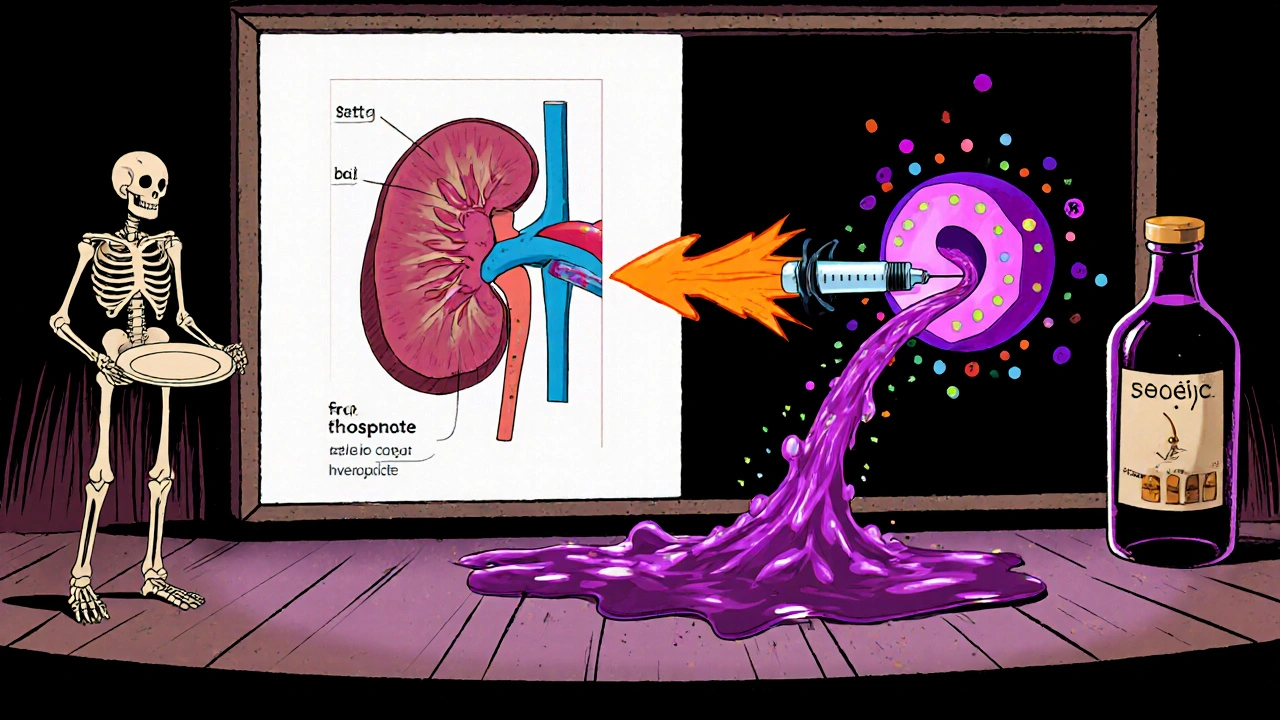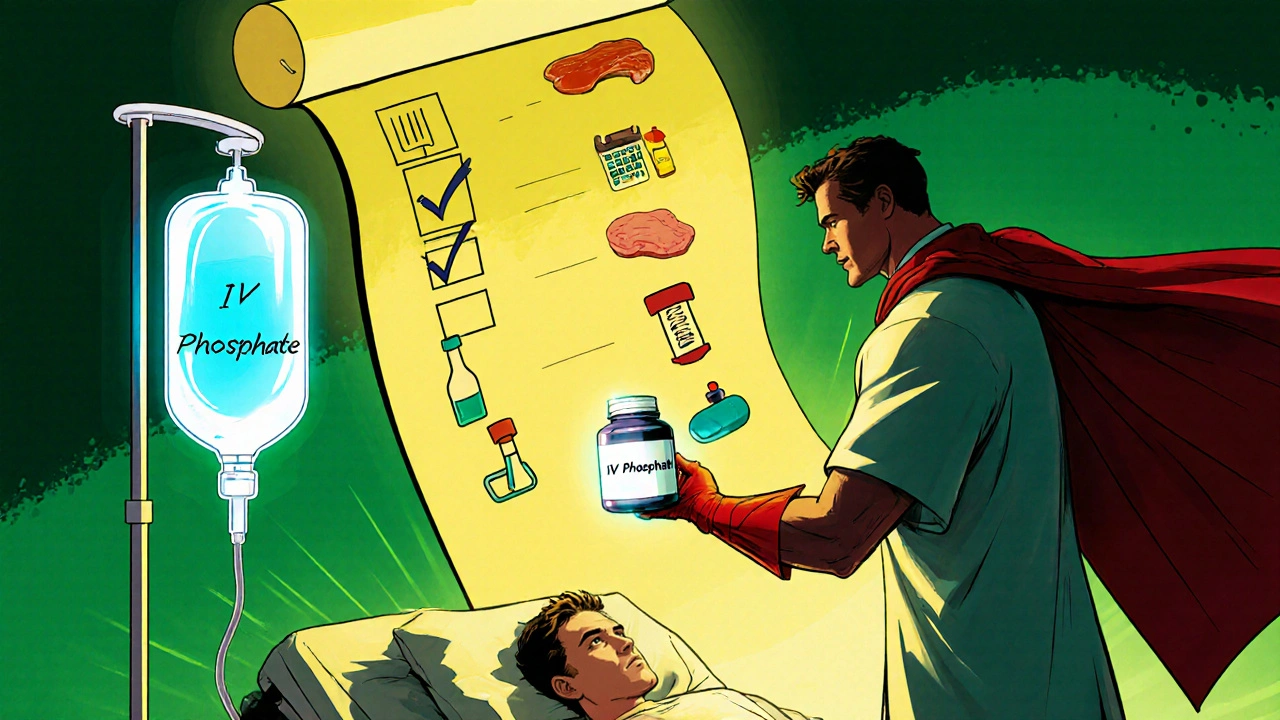Phosphate Replacement Calculator
Input Parameters
Treatment Guidance
Enter values and click calculate to see treatment recommendations
Key Takeaways
- Hypophosphatemia is a low level of phosphate in the blood that can trigger serious organ dysfunction.
- It often appears alongside other electrolyte disturbances such as low potassium or magnesium.
- Common triggers include malnutrition, refeeding syndrome, alcohol abuse, and certain kidney problems.
- Prompt diagnosis relies on serum phosphate testing and a look at accompanying electrolytes.
- Treatment ranges from oral supplements for mild cases to IV phosphate for severe, life‑threatening drops.
If you’ve ever heard the term “electrolyte imbalance” and wondered how phosphate fits into the picture, you’re not alone. Low phosphate-known medically as hypophosphatemia is a condition where blood phosphate concentrations fall below the normal reference range (typically < 2.5 mg/dL)-can sneak up on patients and cause problems that ripple through muscles, the heart, and even the respiratory system. This guide breaks down what the condition is, why it matters, and how to manage it without getting lost in medical jargon.
What Is Hypophosphatemia?
Phosphate is a mineral that plays a starring role in energy production, bone strength, and cell signaling. When levels dip, the body’s ability to generate ATP-a molecule that fuels every cell-drops sharply. Electrolyte imbalance is a broader disturbance involving any of the body’s electrically charged minerals, such as sodium, potassium, calcium, magnesium, and phosphate. In practice, a drop in phosphate often co‑occurs with shifts in those other minerals, creating a cascade that can be hard to untangle without a clear diagnostic plan.
How Low Phosphate Connects to Other Electrolyte Shifts
Phosphate doesn’t work in isolation. It shares transport pathways with potassium and magnesium, meaning that when you fix one, the others may move as well. For instance, aggressive phosphate repletion can drag potassium into cells, risking hypokalemia. Conversely, untreated hypomagnesemia can blunt the body’s response to phosphate supplementation. Understanding these links helps clinicians avoid “fix‑one‑thing” pitfalls and monitor the full electrolyte panel throughout treatment.
Common Causes and Who’s at Risk
Below are the most frequent culprits you’ll see in hospitals or outpatient clinics:
- Malnutrition or prolonged fasting - low intake of phosphate‑rich foods.
- Refeeding syndrome - a rapid influx of carbs after starvation pulls phosphate into cells for ATP synthesis.
- Alcohol abuse - chronic drinking interferes with renal phosphate handling.
- Diabetic ketoacidosis (DKA) treatment - insulin drives phosphate into cells.
- Renal loss - certain diuretics or genetic tubulopathies increase urinary phosphate excretion.
Patients who are critically ill, post‑surgical, or undergoing bariatric procedures also sit in a higher risk bucket.

Signs and Symptoms to Watch For
Because phosphate is so tied to energy metabolism, symptoms often reflect energy‑starved tissues:
- Muscle weakness or cramping, especially in the thighs.
- Respiratory failure - the diaphragm can fatigue quickly.
- Hemolysis - red blood cells become fragile, leading to anemia.
- Cardiac arrhythmias - low phosphate can destabilize the heart’s electrical system.
- Neurologic changes - irritability, confusion, or seizures in severe cases.
These signs can look like other electrolyte disorders, which is why a lab check is essential.
Diagnosing Low Phosphate
The gold standard is a serum phosphate test. Normal adult ranges sit between 2.5 and 4.5 mg/dL (0.81‑1.45 mmol/L). Values below 2.0 mg/dL signal mild hypophosphatemia; under 1.0 mg/dL is considered severe and warrants urgent action. Serum phosphate is the laboratory measurement used to confirm hypophosphatemia and guide treatment decisions. When a low result appears, labs should also check potassium, magnesium, calcium, and bicarbonate to map the full electrolyte picture.
Treatment Options: Oral vs. IV Replacement
Therapy choice hinges on severity, underlying cause, and how quickly phosphate needs to rise. Below is a quick visual guide.
| Aspect | Oral Supplementation | IV Phosphate Therapy |
|---|---|---|
| Typical Indication | Mild to moderate (phosphate >1.0 mg/dL) | Severe, symptomatic, or hypophosphatemia < 1.0 mg/dL |
| Formulations | Calcium phosphate tablets, sodium phosphate powder | Monobasic sodium phosphate or potassium phosphate IV solutions |
| Usual Dose | 250‑500mg elemental phosphate PO q6‑8h | 0.08‑0.16mmol/kg over 6h (max 1mmol/kg/24h) |
| Monitoring | Serum phosphate q12‑24h, watch for GI upset | Serum phosphate q4‑6h, watch calcium, potassium, magnesium |
| Risks | Diarrhea, phosphate binding with calcium (hypocalcemia) | Hyperphosphatemia, calcium‑phosphate precipitation, hypotension |
Oral therapy is convenient for outpatient follow‑up, but it works slowly. IV therapy delivers a rapid boost, making it lifesaving when respiratory muscles fail or when the patient cannot take anything by mouth.

Handling Related Electrolyte Changes
When you replace phosphate, the body may shift potassium and magnesium. A practical rule of thumb: for every 0.5mmol/L rise in serum phosphate, expect a 0.2‑0.3mmol/L drop in serum potassium. Therefore, clinicians often give a modest potassium supplement alongside phosphate, especially if the baseline potassium is already low. The same vigilance applies to magnesium, as low magnesium can blunt the effectiveness of both potassium and phosphate repletion.
Preventing Future Episodes
Prevention is about identifying risk and ticking off a checklist before discharge:
- Screen high‑risk patients (malnourished, alcoholic, post‑surgery) with a baseline serum phosphate.
- When initiating nutrition after a fast, start with low‑calorie, low‑carbohydrate feeds and add phosphate gradually.
- Educate patients on foods rich in phosphate-dairy, meat, nuts, and legumes.
- Review medication lists for phosphate‑wasting drugs (certain diuretics, antacids).
- Schedule follow‑up labs within 48‑72hours of any major intervention (e.g., starting insulin for DKA).
By catching a dip early, you can often correct it with oral supplements, sparing the patient an IV line and the hospital a costly stay.
Frequently Asked Questions
What blood level defines hypophosphatemia?
A serum phosphate below 2.5mg/dL (0.81mmol/L) is considered low; values under 1.0mg/dL are severe and usually need IV treatment.
Can I prevent low phosphate by changing my diet?
Yes. Regular intake of dairy products, meat, fish, nuts, and legumes provides ample phosphate. However, if you have kidney disease, talk to a doctor before increasing phosphate.
Why does refeeding syndrome cause hypophosphatemia?
When calories, especially carbs, flood the bloodstream after a period of starvation, insulin spikes and drives phosphate into cells for ATP production, dropping blood levels sharply.
Is it safe to take over‑the‑counter phosphate supplements?
Self‑medicating can cause too much phosphate, leading to calcium‑phosphate crystals in kidneys. Use supplements only under medical guidance, especially if you have kidney or heart disease.
How quickly does IV phosphate raise serum levels?
Rapid IV infusions can raise serum phosphate by 0.5‑1.0mg/dL within 6hours, but clinicians monitor closely to avoid overshoot.

16 Comments
Val Vaden October 15 2025
Another boring electrolyte rundown 🙄
lalitha vadlamani October 16 2025
It is profoundly disconcerting that contemporary medical literature continues to treat hypophosphatemia as a mere footnote rather than the grave menace it truly represents. In the grand hierarchy of physiological disorders, phosphate deficiency unequivocally occupies a pivotal niche, orchestrating the symphony of cellular energetics. One cannot simply dismiss the cascading effects on myocardial contractility, neurological function, and respiratory mechanics without sounding the alarm. The ethical imperative, therefore, mandates that clinicians vigilantly monitor serum phosphate levels, especially in high‑risk cohorts such as malnourished patients and those undergoing aggressive nutritional rehabilitation. Moreover, the intertwined nature of electrolyte homeostasis demands a holistic approach; treating phosphate in isolation is tantamount to treating a symptom while ignoring the underlying disease. Consider, for instance, the pernicious cycle wherein aggressive phosphate repletion precipitates hypokalemia, thereby compounding cardiac risk. Likewise, an uncorrected hypomagnesemia may render phosphate replacement futile, a fact often overlooked in hasty protocols. The literature must, consequently, underscore the necessity of simultaneous assessment of potassium, magnesium, and calcium when devising a repletion regimen.
Furthermore, the specter of refeeding syndrome looms large, a clinical entity wherein the abrupt influx of carbohydrates catalyzes a precipitous intracellular phosphate shift, precipitating severe hypophosphatemia. This phenomenon is not merely a biochemical curiosity; it has been documented to precipitate acute respiratory failure and even death. Thus, a judicious, stepwise refeeding strategy, complemented by prophylactic phosphate supplementation, is not optional but essential. In addition, the role of renal handling of phosphate, modulated by diuretics and certain antacids, must be factored into any comprehensive management plan. The clinician’s duty extends beyond acute correction; it encompasses patient education on dietary sources of phosphate, such as dairy, meat, nuts, and legumes, to forestall recurrence.
In summation, hypophosphatemia is not a peripheral concern but a central pillar of electrolyte equilibrium. Its recognition, prompt intervention, and preventative strategies are indispensable to safeguarding patient outcomes. Let us, therefore, eschew complacency and elevate our vigilance to the level this condition unquestionably demands.
kirk lapan October 17 2025
Yo, wtf? The whole "hypophosfatemia" thing isn’t some mystical dragon you need to slay with random pills. First off, you gotta check the labs – 2.4 mg/dL? That’s borderline, not a code red. Second, if you’re just dumping oral phosphates without watching potassium or mg, you’re practically inviting arrhythmia. Also, your table – the IV dosing numbers look off by a factor of ten, which could cause hyperphosphatemia fast. TL;DR: Test, monitor, dose right, don’t just wing it.
Landmark Apostolic Church October 18 2025
Reading through this made me think about the bigger picture of balance. Phosphate isn’t just a number; it’s a bridge between energy production and structural integrity. When it dips, the whole system feels the strain, kind of like a quiet protest that escalates if ignored. It reminds us that every electrolyte is a participant in a larger dialogue, and silencing one voice can mute the chorus.
Matthew Moss October 18 2025
Patriotic doctors must recognize that low phosphate jeopardizes our nation’s health. Simple facts: malnutrition, alcohol, and poor diet are at the root. We need strong policies to ensure proper nutrition, otherwise the populace suffers.
Antonio Estrada October 19 2025
I appreciate the thoughtful perspective on systemic balance. It is indeed important to consider how each electrolyte interacts within the organism. Maintaining that harmony through careful monitoring aligns with best practices and should be emphasized in clinical education.
Andy Jones October 20 2025
Wow, another “let's list every BMP component” post. Did anyone bother to mention that the normal range varies with lab methodology? Also, your table lacks a column for calcium‑phosphate product, which is crucial to avoid precipitation. Guess we’re back to basics.
Kevin Huckaby October 21 2025
Ha! As if anyone’s reading the fine print. 🙃 The real issue is that most clinicians treat numbers like they’re on a quiz, not a patient. Let’s stop playing bingo with labs and start caring about the human behind the values. 🌈
Brandon McInnis October 22 2025
It’s fascinating how an electrolyte that most of us have never heard of can cause such dramatic symptoms. From muscle cramps to respiratory failure, phosphate truly is the unsung hero (or villain) of our internal chemistry. Kudos to the author for shedding light on this.
Allison Marruffo October 23 2025
Great summary! I especially like the step‑by‑step prevention checklist. It gives clinicians a clear roadmap and reduces the chance of missing a low phosphate in high‑risk patients.
Ian Frith October 24 2025
From a clinical standpoint, the interplay between phosphate, potassium, and magnesium is often underappreciated. When you replenish phosphate, you must anticipate the intracellular shift of potassium and the buffering role of magnesium. Otherwise, you risk swapping one electrolyte disorder for another. The article could benefit from a brief algorithm that flags when concurrent supplementation is warranted. Nonetheless, the depth of explanation regarding ATP production and muscle fatigue is spot‑on and helps clinicians appreciate why patients feel so weak during hypophosphatemia.
Beauty & Nail Care dublin2 October 25 2025
Ok, so the whole "phosphate is just another lab" vibe is a total con. The big pharma PR team want us to think it’s safe, but the truth is hidden: low phosphate can trigger secret government bioweapon trials. They never tell you that. *cough*
Oliver Harvey October 25 2025
Nice attempt, but the grammar in the treatment section is a mess. "Severe, symptomatic, or hypophosphatemia < 1.0 mg/dL" – should be "hypophosphatemia < 1.0 mg/dL" with proper spacing. Also, avoid dangling modifiers like "when aggressive phosphate repletion"; it reads oddly.
Ben Poulson October 26 2025
Thank you for pointing out the typographical errors. Precise language is essential in medical documentation, particularly when dosing recommendations are presented. I recommend a thorough proofread to ensure clarity and safety.
Anna Graf October 27 2025
Phosphate matters. Low levels hurt you. Eat dairy and meat.
Lindy Fujimoto October 28 2025
Honestly, you’ve reduced a complex physiological dance to a bland grocery list. 🙄 It’s like saying “just drink water” when someone’s drowning. 😤 Let’s give credit to the cascade of hormones, transporters, and cellular signals that make this whole thing work-or fail. 🚀